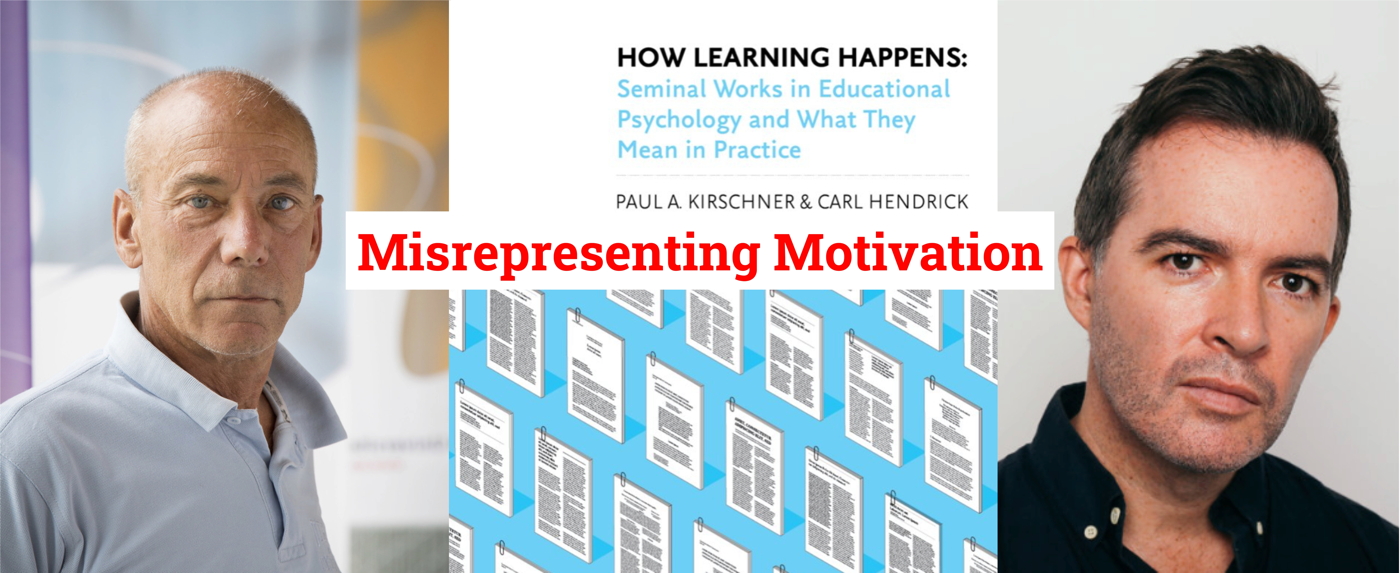The Book How Learning Happens Misrepresents Motivation

The book How Learning Happens presents a plague-ridden factual nit about motivation that I feel compelled to pick.
This particular nit contributes to the epidemic of disengagement in K-12 schools, so I think it is well worth picking.
Teaching is hard enough without aspiring teachers being misled about the nature and role of motivation in how learning happens.
Three brief quotes about motivation from the book by Kirschner & Hendrick (2020) will be examined.
These statements are problematic from my perspective as an expert on Self-Determination Theory (SDT), the most thoroughly supported scientific explanation of motivation in the world today, and how it applies in K-12 schools.
Since the statements analyzed below are not precisely true, but they are also not entirely false, I suggest that they should be considered void for vagueness.
The true role of motivation in how learning happens
A brief explanation of the science of motivation according to Self-Determination Theory is necessary.
First, motivation is inherent to being human.
The appearance of a lack of motivation is the result of a situation in which some or all of the primary psychological needs for relatedness, autonomy, and competence have been consistently thwarted.
Motivation occurs along a spectrum that we can, for convenience, divide into two parts: controlled and autonomous.
Controlled motivations diminish well-being, while autonomous motivations improve well-being.
Well-being is necessary for the deeper learning we expect our schools to facilitate.
Thus, the causal chain for positive outcomes goes from the satisfaction of primary needs (causing well-being) to autonomous motivations to agentic engagement to deep learning.
The causal chain for negative outcomes goes from the thwarting of primary needs (diminishing well-being) to controlled motivations to disengagement to shallow learning.
Deep learning does NOT automatically follow from the prior steps in the positive causal chain because other factors (such as poor instruction) can prevent it.
But shallow learning DOES follow from the prior steps in the negative causal chain because ill-being undermines the effectiveness of all other factors.
In summary, autonomous motivations open the mental door to deep learning, while controlled motivations close it.
If students will have arrived in their classroom with some sense that the decision to attend was made by someone whom they trust to have had their needs, interests, values, and goals in mind that would be the best scenario.
Most children trust themselves the most in that regard, but other people (such as moms and teachers, see Bao & Lam, 2008) can sometimes be trusted, too.
This means that students actively making the choice to take classes is the ideal.
However, it is still plausible for them to learn deeply in classes they did not choose, BUT ONLY if their needs, interests, values, and goals are robustly supported after they arrive in that class.
If the students in a class already have autonomous motivations for their participation, it is perfectly plausible that teacher-centric practices (such as the direct instruction that is advocated by Kirschner and his colleagues) will be effective.
If students have controlled motivations, it would be more effective to begin with student-centered practices in order to activate and direct their motivational resources towards supporting the values and goals of the class.
A quote from How Learning Happens
"There is neither a causal relationship (motivation does not lead to better learning and performance) nor a reciprocal relationship (in the sense that motivation leads to learning and learning leads to motivation) between motivation and learning. It’s learning that leads to motivation." [p. 302]
This quote is making causal claims about motivation.
The chapter in which it appears is called “The Ten Deadly Sins in Education” and the section is called “8. Motivation leads to learning,” thus they regard believing that statement to be a DEADLY sin.
The sentence can be broken down into a set of three causal claims which I will rephrase slightly by inserting a phrase that clarifies that we are, of necessity, referring to patterns of motivation (which are always present in various forms), not the mere existence of motivation, and stating each as a positive assertion about causes.
A) improved patterns of motivation cause better learning and performance (they disagree)
B) improved patterns of motivation cause learning AND learning causes improved patterns of motivation (they disagree)
C) learning causes improved patterns of motivation (claim A in reverse, they agree)
All three causal claims are problematic because when precise language about motivation is used and the effects rigorously researched there is no evidence of a direct causal interaction between motivation and learning.
Self-Determination Theory (SDT) has thoroughly established over decades of well-replicated research that satisfaction or thwarting of primary psychological needs are causes of mental well-being or ill-being respectively.
Those causes of mental well/ill-being ALSO cause patterns of motivation to change in predictable ways, both for better and for worse.
The predictability of the changes is what makes SDT the most useful and generally accurate account of human motivation in the world today.
When a student is on the controlled side of the spectrum of motivation then that will diminish that student’s learning because of the deterioration of mental well-being that goes along with it.
It is not reasonable to posit the idea that ill-being has no effect on learning, but I don’t think any of the quotes went there, so no problem.
However, these statements are only correct to the degree that the establishment of positive mental well-being, by being on the autonomous side of the spectrum, does NOT ensure that deep conceptual learning will take place.
There are many other factors (especially instructional techniques) that can either facilitate or interfere with that process.
However, this sliver of truth does not redeem these statements.
Two more quotes from How Learning Happens
"As Graham Nuthall (2007) reminds us: ‘Learning requires motivation, but motivation does not necessarily lead to learning’." [p. 81]
"Motivation doesn’t always lead to achievement, but achievement often leads to motivation." [p. 82]
In the second quote the word “achievement” is being used in the same way that Nuthall was using “learning” in the first quote thus equating them.
It would be more accurate to say “learning” and/or “achievement” are correlated with improvements to the patterns of motivation.
The context of these two quotes is a chapter about Carol Dweck’s research into fixed versus growth mindsets, which teased out one way that a student’s beliefs about the causes of intelligence can affect their selection of strategies for learning in mainstream classrooms.
Dweck’s work is narrowly focused on a minor factor within motivation.
Her mindset work is popular within the field of education but that, unfortunately, seems to cause it to overshadow the major factors for motivation articulated by Self-Determination Theory.
The main problem with these statements is the use of terms that are not used in the psychological research literature on motivation.
The broader question is: What causes the patterns of motivation that we observe in humans across all contexts, not just in the classroom?
Being alive and awake means that there is attentional energy that is generated and directed towards some form of goal or aspiration (even if only to implicitly seek to satisfy inherent primary needs) with some degree of persistence.
What I just described is constructed from the literal definition of motivation.
Beliefs are a minor factor compared to the primary psychological needs that have been robustly studied by the SDT community.
Kirschner & Hendrick made these statements as they are concluding the chapter by framing Dweck’s work in a larger context.
But, neither “learning” nor “achievement” CAUSE any particular pattern of motivation.
Motivation is an inherent property of being human, so the assertion that anything other than being alive and awake “causes motivation” is, on the face of it, false.
Imagine you make a simple statement, similar to the one above, in the staffroom, “X leads to motivation,” where you can fill in just about any psychologically relevant factor in place of the “X.”
There is enough shared commonsense understanding of learning that whatever you said could be somewhat true.
The stakes of believing that statement are low; it just doesn’t make much of a difference one way or another.
On the other hand, if you said, “Drinking cyanide leads to motivation,” it is obvious that there is a huge problem with anyone taking that statement seriously and you would expect me to reply with sufficient rigor and vigor to ensure that no harm comes from such an absurd statement.
My challenge here is that these statements about motivation are somewhat true and probably consistent with your commonsense notions of learning, so that you will assume the stakes for believing it, or not, are low.
I will come across as a pedantic nit-picker if I assert, “Motivation is an inherent property of being human, so any claim about what ‘causes motivation,’ other than being alive and awake, is wrong.”
This statement may be scientifically true, but it can be socially awkward.
It will be especially awkward if I respond with a degree of rigor and vigor that mismatches your assessment of the stakes in the discussion.
I am pedantically picking this nit because it carries an educational plague.
I believe the stakes are high, that acting in accordance with these false beliefs is currently causing harm to teachers and students in teacher-centric schools as demonstrated by the consistent observation of disengagement in K-12 schools around the globe.
The misunderstandings that result from believing these partial truths are being used to justify practices that are thwarting the primary needs of both teachers and students.
To be clear, the teacher-centric practices that Kirschner and his colleagues promote are not, in and of themselves, educationally problematic.
They become problematic when they cause psychological harm to students and teachers.
Currently, the clear and consistent observations of disengagement suggests that the organization of most mainstream schools makes teacher-centric practices inappropriate.
If there was evidence that students were having their psychological needs satisfied, their motivations for participating in instructional activities were autonomous, and their engagement agentic, then teacher-centric practices are perfectly appropriate.
Currently, controlled motivations and disengagement are the norm, thus teacher-centric instructional practices are not called for.
Here’s what I know from SDT: The satisfaction of primary needs, which are universal aspects of being human, has been proven to cause changes in patterns of motivation.
There are plenty of correlations with changes in motivational patterns that have been established but primary needs have the most robust (maybe the only) scientific evidence to support causal claims regarding human motivation.
This means that the assertions made in the How Learning Happens book about motivation are only true to the degree that the vague terms they used could include the satisfaction of the needs of the learners.
This is not a stretch since competence is one of those needs.
It is particularly important to note how the power structures of most classrooms do NOT encourage teachers to take the needs, interests, values, and goals of their students into account (this is why they are called teacher-centric).
When a teacher succumbs to the pressures of high stakes testing, arbitrary timelines for covering large quantities of content, or other requirements imposed from the-powers-that-be, what they are necessarily sacrificing are opportunities to better accommodate the needs, interests, values, and goals of their students.
That power structure is a consequence of organizational, cultural, and societal factors that exist independent of all of the teachers and students in any particular school.
Those power structures do not entirely preclude skillful and compassionate teachers from taking students needs, interests, values, and goals into account, but given the predominant patterns that have been consistently observed they tend to discourage teachers from making that kind of effort.
The semantics of the quotes I’ve chosen could be taken to imply that motivation is either an on-or-off binary factor, but scientifically speaking, the off side only occurs during sleep and upon death, which I am certain were not the circumstances the authors had in mind.
So, their statements are true only in the sense that all students are motivated, and the mere existence of motivation did not lead to learning, which they (erroneously) equate to achievement.
The three quotes reviewed above are effectively false from the perspective that being vague should void their value.
The original authors were clearly not well-versed in Self-Determination Theory.
Their uses of the words “motivation,” “learning,” and “achievement” all fail to convey clearly and accurately how those ideas relate to each other and the roles they play in how learning happens.
As mentioned above there is a scientific truth buried in those quotes, but it took a substantial effort to tease it out, thus the sentences should be regarded as communicative failures.
Teaching is hard enough without being confused about the psychology of motivation.
How Learning Happens is a volume worth having because this single flaw does not invalidate the rest of the book.
The truth is that the techniques for achieving autonomous motivations in most students are not terribly difficult to use, but as with any cultural pattern they require consistent support from the organizational and societal levels.
The misrepresentation of motivation in this kind of resource for pre-service teachers is tragic when it reinforces the misapplication of direct instruction to students who are not in the right frame of mind to take full advantage of the instructor’s efforts.
Update: Since writing this a new research report testing the notion that achievement leads to motivation has been released. They found that autonomous motivations lead to achievement however controlled motivations had no effect on achievement (neither positive nor negative). Does motivation lead to academic success, or conversely? Reciprocal relations between autonomous and controlled motivation, and mathematics achievement by Santana-Monagas, etal (2025)
—
You can learn more about the science of motivation by taking my free Motivation Myth-Busting Course for Teachers.
The course consists of three videos which are each 20-30 minute long.
They will be delivered to your in-box each week for three weeks.
Citations
Bao, X., & Lam, S. (2008). Who makes the choice? Rethinking the role of autonomy and relatedness in Chinese children’s motivation. Child Development, 79(2), 269-283. DOI: 10.1111/j.1467-8624.2007.01125.x
Kirschner, P. A., & Hendrick, C. (2020). How learning happens: Seminal works in educational psychology and what they mean in practice. Routledge.

This article was printed from HolisticEquity.com




